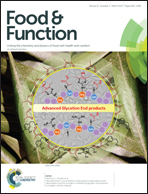Contribution of the phenolic composition to the antioxidant, anti-inflammatory and antitumor potential of Equisetum giganteum L. and Tilia platyphyllos Scop.
Abstract
Naturally-occurring phytochemicals have received pivotal attention in the last few years, due to the increasing evidence of biological activities. Thus, in the present study, the antioxidant, anti-inflammatory and antitumor potentials of hydroethanolic extracts rich in phenolic compounds obtained from Equisetum giganteum L. and Tilia platyphyllos Scop. were assessed and directly correlated with their content of phenolic compounds, by using HPLC-DAD-ESI/MS analysis. T. platyphyllos showed the higher bioactive potential, evaluated in terms of antioxidant (radical scavenging effects – 105 μg mL−1, reducing power – 123 μg mL−1, β-carotene bleaching inhibition – 167 μg mL−1, and lipid peroxidation inhibition – 56 μg mL−1), anti-inflammatory (225 μg mL−1 inhibited 50% of nitric oxide production) and antitumor (breast – 224 μg mL−1; lung – 247 μg mL−1; cervical – 195 μg mL−1 and hepatocellular – 173 μg mL−1 carcinoma cells) activity, without having cytotoxic effects (>400 μg mL−1). These biological properties were positively correlated with its content and composition of phenolic compounds. Flavonoid contents were markedly higher than the content of phenolic acids, in both samples, being respectively 50.4 mg g−1 and 11.65 mg g−1 for T. platyphyllos, and 21.7 mg g−1 and 4.98 mg g−1 for E. giganteum. Moreover, while in E. giganteum extract, kaempferol-O-glucoside-O-rutinoside was the most abundant flavonoid, in T. platyphyllos extract protocatechuic acid and (−)-epicatechin were the most abundant phenolic acid and flavonoid, respectively. In relation to their content of phenolic acids, protocatechuic and caffeic acids existed in higher abundance in T. platyphyllos and E. giganteum hydroethanolic extracts, respectively. However, it would be interesting to evaluate the in vivo efficacy of both plant extracts to unveil the involved modes of action and to establish effective therapeutic doses.



 Please wait while we load your content...
Please wait while we load your content...